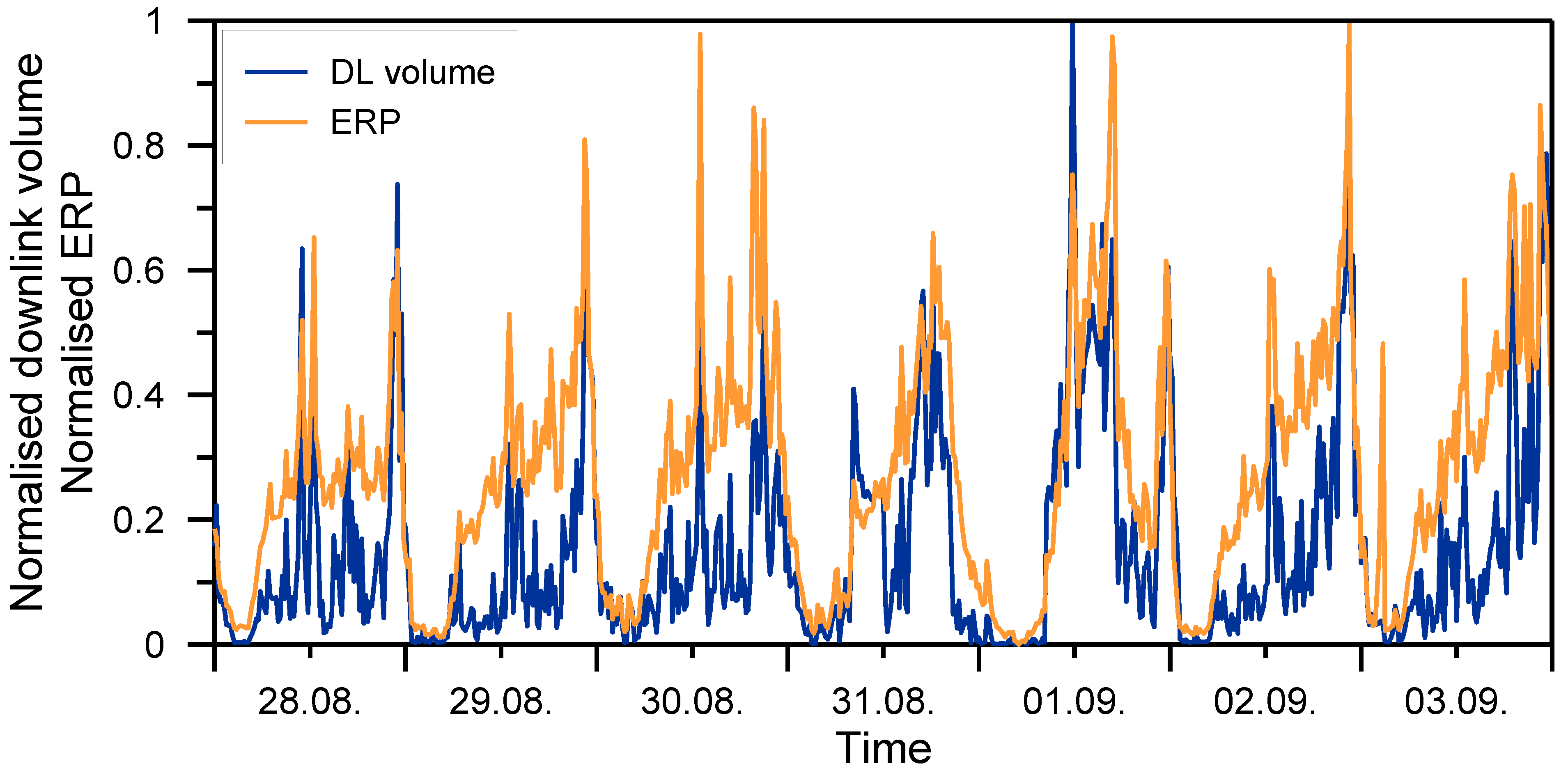Time Averaged Transmitter Power and Exposure to Electromagnetic Fields from Mobile Phone Base Stations
Abstract
:1. Introduction
2. Methods
2.1. Equivalent Radiated Power, Transceivers and Carriers


2.2. GSM
2.3. UMTS
2.3.1. General Considerations
2.3.2. UMTS Power Monitoring

2.4. LTE
3. Results and Discussion
3.1. Duty Factors for GSM


| Number of carriers ntrx | F24, Lehmann et al. [1] | F24 this paper | Fday | Fnight |
|---|---|---|---|---|
| 1 | 1.00 | 1.00 | 1.00 | 1.00 |
| 2 | 0.60 | 0.60 | 0.65 | 0.5 |
| 3 | 0.43 | 0.43 | 0.48 | 0.33 |
| 4 | 0.35 | 0.35 | 0.40 | 0.25 |
| 5 | 0.28 | 0.30 | 0.35 | 0.20 |
| 6 | 0.25 | 0.27 | 0.32 | 0.17 |
3.2. Duty Factors for UMTS
- Fmin: The minimum of the 15-min ERP averages divided by ERPop.
- Fmax: The maximum of the 15-min ERP averages divided by ERPop.
- 〈F24〉 : F24 averaged over the cells of a group


3.3. Duty Factors for LTE
4. Conclusions
Fnight = 0.25 ± 0.06
F24 = 0.32 ± 0.08
Supplementary Files
Supplementary File 1Acknowledgments
Author Contributions
Conflicts of Interest
References
- Lehmann, H.; Herrmann, U.; Eicher, B.; Trostel, A.; Fritschi, P.; Moser, M. General Public Exposure to Electromagnetic Fields Generated by Mobile Phone Base Stations: A Simple Model. Proceedings of the COST-281 Workshop on RF Exposure Assessment, Paris, France, 20–21 September 2004; Available online: http://www.bag.admin.ch/themen/strahlung/00053/00921/00922/index.html (accessed on 6 June 2014).
- Bürgi, A.; Theis, G.; Siegenthaler, A.; Röösli, M. Exposure modeling of high-frequency electromagnetic fields. J. Expo. Sci. Environ. Epidemiol. 2008, 18, 183–191. [Google Scholar] [CrossRef]
- Bürgi, A.; Frei, P.; Theis, G.; Mohler, E.; Braun-Fahrländer, C.; Fröhlich, J.; Neubauer, G.; Egger, M.; Röösli, M. A model for radiofrequency electromagnetic field predictions at outdoor and indoor locations in the context of epidemiological research. Bioelectromagnetics 2010, 31, 226–236. [Google Scholar]
- Beekhuizen, J.; Vermeulen, R.; Kromhout, H.; Bürgi, A.; Huss, A. Geospatial modelling of electromagnetic fields from mobile phone base stations. Sci. Total Envir. 2013. [Google Scholar] [CrossRef]
- NIS-Monitoring Zentralschweiz Exposure Map. Available online: http://www.e-smogmessung.ch (accessed on 2 June 2014).
- Kataster der Hochfrequenten Nichtionisierenden Strahlung für die Kantone Basel-Stadt und Basel-Landschaft. Available online: http://www.baselland.ch/main_elektro-htm.273859.0.html (accessed on 2 May 2014).
- Beekhuizen, J.; Kromhout, H.; Bürgi, A.; Huss, A.; Vermeulen, R. What input data are needed to accurately model electromagnetic fields from mobile phone base stations? J. Expo. Sci. Environ. Epidemiol. 2014. [Google Scholar] [CrossRef]
- ONIR: Ordinance Relating to Protection from Non-Ionising Radiation, SR 814.710, Swiss Federal Council, 1999, Non-Binding Engish Taznslation. Available online: http://www.bafu.admin.ch/elektrosmog/01079/index.html?lang=en#sprungmarke3_24 (accessed on 2 June 2014).
- NAO: Noise Abatement Ordinance, SR 814.41, Swiss Federal Council, 1986, Non-Binding Engish Taznslation. 1986. Available online: http://www.admin.ch/opc/en/classified-compilation/19860372/201212280000/814.41.pdf (accessed on 2 June 2014).
© 2014 by the authors; licensee MDPI, Basel, Switzerland. This article is an open access article distributed under the terms and conditions of the Creative Commons Attribution license (http://creativecommons.org/licenses/by/3.0/).
Share and Cite
Bürgi, A.; Scanferla, D.; Lehmann, H. Time Averaged Transmitter Power and Exposure to Electromagnetic Fields from Mobile Phone Base Stations. Int. J. Environ. Res. Public Health 2014, 11, 8025-8037. https://doi.org/10.3390/ijerph110808025
Bürgi A, Scanferla D, Lehmann H. Time Averaged Transmitter Power and Exposure to Electromagnetic Fields from Mobile Phone Base Stations. International Journal of Environmental Research and Public Health. 2014; 11(8):8025-8037. https://doi.org/10.3390/ijerph110808025
Chicago/Turabian StyleBürgi, Alfred, Damiano Scanferla, and Hugo Lehmann. 2014. "Time Averaged Transmitter Power and Exposure to Electromagnetic Fields from Mobile Phone Base Stations" International Journal of Environmental Research and Public Health 11, no. 8: 8025-8037. https://doi.org/10.3390/ijerph110808025




